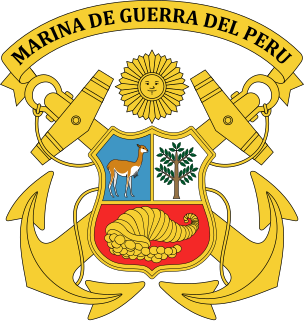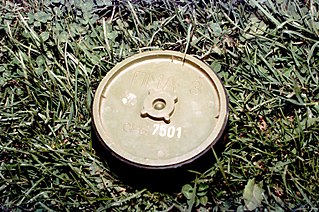
The M18A1 Claymore is a directional anti-personnel mine developed for the United States Armed Forces. Its inventor, Norman MacLeod, named the mine after a large Scottish medieval sword. Unlike a conventional land mine, the Claymore is command-detonated and directional, meaning it is fired by remote-control and shoots a pattern of metal balls into the kill zone like a shotgun. The Claymore can also be victim-activated by booby-trapping it with a tripwire firing system for use in area denial operations.

The Peruvian Navy is the branch of the Peruvian Armed Forces tasked with surveillance, patrol and defense on lakes, rivers and the Pacific Ocean up to 200 nautical miles from the Peruvian littoral. Additional missions include assistance in safeguarding internal security, conducting disaster relief operations and participating in international peacekeeping operations.

The RG-31 Nyala is a 4×4 multi-purpose mine-resistant ambush protected infantry mobility vehicle manufactured in South Africa by Land Systems OMC and in Turkey by FNSS Defence Systems. It is based on the Mamba APC of TFM Industries.

The RG-32 Scout is a family of mine-resistant 4×4 light armoured vehicles made by BAE Systems Land Systems South Africa in South Africa. It is based on the RG-31, which is already deployed worldwide with peace-keeping, security and combat forces. The combat weight of the vehicle is about 7,300 kg and it has the capacity to carry a crew of 5 to 7. The vehicle crew is protected against 5.56×45mm NATO ball ammunition, grenades, firebombs, anti-personnel mines and side blasts. The five-seat version also offers protection against anti-tank mines and side blasts. Up to two RG-32Ms can be transported in a C-130 cargo aircraft.

Maharashtrawadi Gomantak Party (MGP) was Goa's first ruling party after the end of Portuguese colonial rule in 1961. In the first elections held after India took over the former Portuguese colony, it ascended to power in December 1963 and stayed on, till being ousted from power by defections in early 1979.
The Peruvian MGP series is a family of 9mm submachine guns and semi-automatic pistols which have been produced by the Peruvian Navy's SIMA CEFAR factory since the 1980s. MGP stands for Marina de Guerra del Peru. Although compact as submachine guns, they are somewhat bulky as pistols.

The BM-27 Uragan is a self-propelled multiple rocket launcher system designed in the Soviet Union. It began its service with the Soviet Army in the late 1970s, and was its first modern spin and fin stabilized heavy multiple rocket launcher.

The PMN series of blast anti-personnel mines were designed and manufactured in the Soviet Union. They are one of the most widely used and commonly found devices during demining operations.

The VS-50 is a circular plastic cased anti-personnel blast mine, formerly manufactured by the now-defunct Valsella Meccanotecnica SpA, an Italian high-tech defence industry specialized in area denial systems which was also the manufacturer of the Valmara 69 and one of the first industries in the world to implement plastic construction for landmines. The design is similar to the TS-50 and VS-MK2 mine. It is blast resistant and can be used in a minimum metal configuration. Though unlikely to kill, the explosive charge contained within a VS-50 is quite sufficient to destroy the victim's foot: the blast is capable of penetrating 5 mm of mild steel leaving an 80 mm-diameter hole.
The SB-81 is an Italian plastic cased minimum metal anti-tank blast mine dating from the early 1980s. The mine uses an air pressure based fuze, which gives it protection against overpressure and blast. It can therefore be regarded as a blast resistant mine. The mine can be scattered by hand or by mine laying systems.
The AC NM AE T1 is a Brazilian minimum metal anti-tank blast mine. The mine is believed to be in service with the Brazilian army, although production of the mine ceased in 1989. The mine has a square plastic main body, with a raised circular pressure plate and fuze. A carry handle is built into one side of the mine. It appears to be very similar to the PRB M3.

The PMA-3 is a Yugoslavian blast resistant minimum metal anti-personnel mine. It is circular, consisting of a plastic upper and lower half joined together by a rubber cover. A safety collar is normally wrapped around the outside of the mine, preventing the upper half of the mine tilting when in transit. Once deployed the safety collar is removed. Sufficient pressure on the top surface of the mine causes it to tilt. The tilting drives a pin through a friction sensitive pyrotechnic compound, which fires the detonator and then the main explosive charge.
NATO AEP-55 STANAG 4569 is a NATO Standardization Agreement covering the standards for the "Protection Levels for Occupants of Logistic and Light Armored Vehicles".
The MGP-15 is a submachine gun designed for issue to special forces made by SIMA-CEFAR, updated with a longer barrel and other features. The name was changed from previous MGP models due to modifications, including a change to a barrel with a threaded muzzle, usually fitted with a screwed-on muzzle cap, that allows a suppressor to be quickly screwed on.
Norway was represented by 16-year-old Silje Vige, with the song '"Alle mine tankar", at the 1993 Eurovision Song Contest, which took place on 15 May in Millstreet, Ireland. "Alle mine tankar" was chosen as the Norwegian entry at the Melodi Grand Prix on 6 March.
Burraq is a Mine-Resistant Ambush Protected (MRAP) Vehicle currently being developed by Heavy Industries Taxila (HIT) of Pakistan. It is a 4x4 Protected vehicle based on the chassis of the Isuzu NPS-75 commercial truck so as to reduce the cost and facilitate the delivery of spare parts. In appearance, the Burraq is quite similar to the Wildcat MRAP, developed by the Israel Military Industries (IMI).

The Textron TAPV is an armoured car currently in use by the Canadian Army. It is essentially a heavier armoured upgrade of the M1117 Armoured Security Vehicle, developed for use by the military police of the US Armed Forces.

The SBA-60K2 Bulat armored personnel carrier (APC) was developed jointly by Kamaz and Zaschita corporation as a private venture. Development of this vehicle commenced in 2010 and was completed by 2013. It is a further development of the earlier BPM-97 6x6 wheeled mine-resistant, ambush protected (MRAP) vehicle. Russia currently employs 15 Bulat vehicles received in late 2014, and ordered a new batch of further 50 vehicles from the Russian manufacturer Zashcita.













